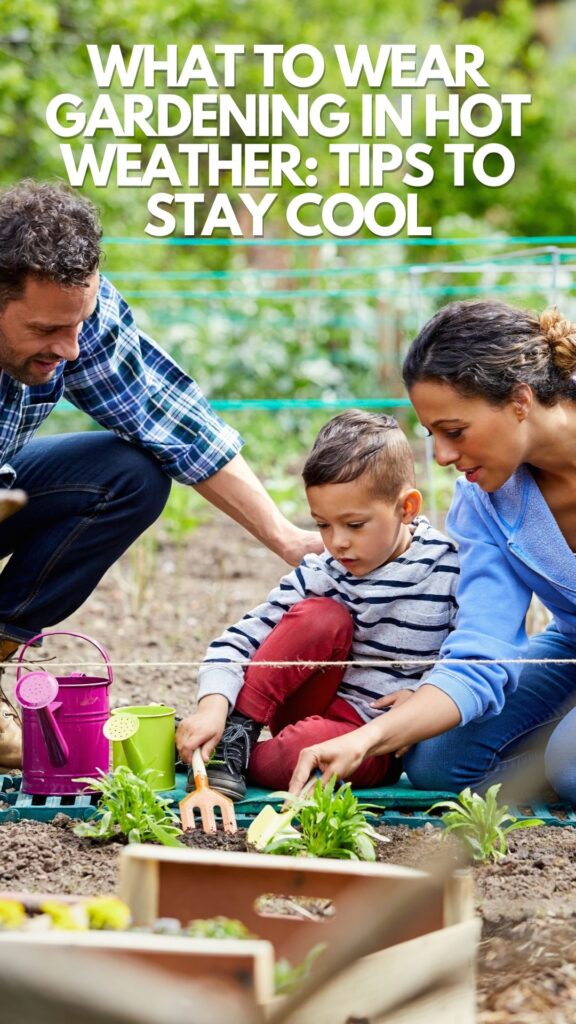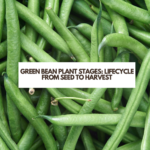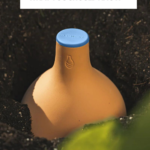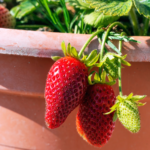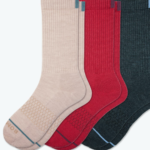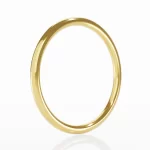Are you wondering what to wear while gardening in hot weather? Figuring out what to wear to garden in the summer can be a bit tricky. Gardening on hot days is a great way to get your exercise in, but only if you have the right clothing and tools.
Gardening in hot weather can be a challenging task, especially when it comes to choosing the right clothing. The primary goals for selecting appropriate attire are staying cool, avoiding sunburn, and preventing injury while working in the garden. By dressing strategically, gardeners can keep their focus on nurturing their garden beds, all while remaining comfortable and safe.
FTC DISCLOSURE: Some of the links in this post are affiliate links. If you click on them and make a purchase, I will receive a small finder’s fee on the sale. This does not increase your price in any way shape or form. Using these links help support the continuation of this website. All opinions are my own. Thank you in advance.
Layering lightweight and breathable fabrics are as essential for staying cool during hot weather gardening as making sure you have enough water. Materials like cotton and linen are ideal for absorbing sweat and allowing air to circulate, preventing overheating. Long sleeves and pants may seem counterintuitive, but covering the skin can actually protect it from the sun’s harmful rays while keeping it cooler.
Additionally, investing in sun protection, such as wide-brimmed hats, UV-protective sunglasses, and high-SPF sunscreen will provide extra defense against sunburn and heat-related problems. These simple practices will ensure that gardeners are well-equipped for the challenges of gardening in hot weather, allowing them to enjoy a productive and comfortable experience.
Choosing the Right Clothing for Gardening in Summer
When gardening in hot weather, it’s essential to choose the proper clothing for both comfort and safety. This section will cover three main aspects to consider: lightweight materials, loose and airy fit, and long sleeves and pants.
Lightweight Materials for gardening during the summer
Selecting fabrics that are lightweight and breathable will help keep you cool while working in your vegetable garden. Some of the best materials for hot weather gardening clothing include:
- Cotton: A natural fiber that is soft, comfortable, and breathable. It has the added benefit of absorbing moisture, helping to keep you dry.
- Linen: Another natural fiber with excellent breathability, linen is known for its ability to wick moisture away from the body, keeping you cool and dry.
Loose and Airy Fit
Wearing clothing with a loose and airy fit is a good choice for maintaining comfort and airflow while gardening in hot weather. This type of fit allows air to circulate around your body, promoting evaporation of sweat and helping to keep your body temperature down. Be sure to avoid tight or restrictive clothing, as it can trap heat and moisture against your skin.
Long Sleeves and Pants
Although it may seem counterintuitive, wearing long sleeves and pants while gardening in hot weather can actually help to keep you cooler and protect you from the sun.
Long sleeves and long pants provide a barrier against the sun’s rays, preventing sunburn and reducing the risk of skin cancer. Choose lightweight, breathable fabrics like cotton and linen for your long sleeves and pants, and look for garments designed specifically for sun protection with built-in UPF (Ultraviolet Protection Factor) ratings or uv-protective clothing.
By focusing on these aspects when selecting your gardening attire, you’ll be able to stay comfortable and safe while working in hot weather conditions. Remember to opt for lightweight materials, a loose and airy fit, as well as long sleeves and pants to ensure the best possible experience in the garden.
Protection from the Sun
Sun Hat Choices for gardening
When gardening in hot weather, it’s essential to protect oneself from the sun. A wide-brimmed sun hat or a wide-brimmed straw hat not only provides ample sun protection, but also keeps the face and neck shielded. A hat with an insect-proof net adds extra protection against pesky bugs.
- Wide-brimmed sun hat: A hat with a brim of at least 3 inches all around, providing excellent coverage for the face, ears, and neck.
- Wide-brimmed straw hat: A breathable option made of natural materials that offers similar protection as the sun hat, with added ventilation.
- Insect-proof net hat: Integrated with a fine mesh net to guard against insects, while still offering sun protection.
Sunglasses for gardening
Sunglasses are another crucial accessory for protecting the eyes from harmful intense UV rays. Choose a pair that blocks 100% of UVA and UVB rays, ensuring maximum protection. Wraparound styles or ones with side shields offer even better coverage, as they prevent rays from entering at different angles.
Sunscreen for gardening
Beyond wearing protective clothing, applying sunscreen is vital for preventing sunburns and reducing the risk of skin cancer. Opt for a broad-spectrum sunscreen with an SPF of at least 30, and remember to reapply every two hours especially after heavy sweating.
Don’t forget those easily overlooked spots, like the ears and the back of the hands. Regular sunscreen use complements the sun protection offered by hats and sunglasses, ensuring a safe and enjoyable gardening experience in hot weather. This is the sunscreen I use on a daily basis.
Gardening Tools and Accessories
Gloves Selection
Choosing the right gardening gloves is essential for working in hot weather. It is important to consider factors like breathability and durability. Nitrile gloves are an excellent option, as they offer a strong grip and are resistant to punctures and cuts that may occur during pruning tasks. For additional comfort, opt for gloves made of lightweight and breathable materials to avoid sweaty hands. Gardening gloves can be used any time of year, so don’t be afraid to splurge on a good pair.
Kneeling and Sitting Comfort
Gardening can be tough on your joints, especially when kneeling or sitting for extended periods. To alleviate this strain, consider using knee pads or a gardening caddy designed for comfort. Knee pads with a thick cushion will provide support and ease pressure on your joints. A gardening caddy with an attached padded seat is another useful accessory that combines storage and comfort.
Storage and Convenience
Organizing your gardening supplies is critical for efficiency and safety, especially in the heat. Items like tool belts and overalls with multiple pockets provide convenient storage for various tools.
- Tool belt: Easily carry essential tools around your waist and have quick access to them.
- Overalls: Provide full-body coverage and have numerous pockets for holding items like seed packets and small tools.
- Apron: Protects clothing while also offering storage pockets for gardening essentials.
When working outdoors, be sure to create shaded areas to keep your tools and accessories protected from direct sunlight. This will help prolong their lifespan and also make your gardening experience and other outdoor activities more enjoyable in the scorching heat.
Footwear Considerations
Sandals and Clogs
When choosing footwear for gardening in hot weather, open-toe options like sandals and clogs are easily accessible. Consider styles made by familiar names, such as Crocs and Birkenstocks. These options promote air circulation, helping to keep your feet cool while you work.
- Crocs: Lightweight and cushioned, these rubber clogs resist water, dirt, and debris, making them ideal for gardening tasks. Look for options with adjustable heel straps for added security.
- Birkenstocks: A popular choice, these sandals offer arch support and a cushioned insole. For gardening, select a waterproof version designed for outdoor use.
Breathable and Comfortable
For closed-toe options, search for light and breathable materials. Work boots or muck boots made with moisture-wicking lining and mesh panels allow for ventilation that keeps your feet cool and dry.
- Work boots: Choose a lightweight work boot with sufficient support and cushioning. Look for options with mesh panels for breathability.
- Muck boots: Rubber or neoprene muck boots can also be an option. Opt for a lightweight, waterproof, and low-cut design for gardening during hot weather.
Durable and Protective
Regardless of your footwear choice, ensure that it provides adequate protection for your feet. Gardening tools can cause injury, and the terrain can be unpredictable. Consider durability and protection in your selection.
- Sole grip: Look for footwear with slip-resistant soles to keep you steady on slippery surfaces.
- Toe protection: For closed-toe options, choose footwear with reinforced or steel toe caps to protect your feet from injury.
- Material: Opt for materials that are durable to withstand daily wear and tear in your garden, such as rubber, leather, or weather-resistant fabrics.
When gardening in hot weather, appropriate footwear is crucial. Choose from options including sandals, clogs, work boots, and muck boots, factoring in breathability, durability, and protection for comfortable and safe gardening experiences.
Staying Cool and Hydrated
Keep Yourself Hydrated
In hot weather, staying hydrated is essential for gardeners. Dehydration can lead to weakness, dizziness, headaches, and nausea. To prevent these symptoms, it is crucial to drink water regularly throughout the day. Gardeners should:
- Start by drinking at least 8 ounces of water before going outside to garden.
- Carry a water bottle and take breaks every 20-30 minutes to drink water.
- Opt for water instead of sugary drinks or caffeine, which can worsen dehydration.
Cooling Techniques for the Body
Keeping the body cool during a heat wave is vital to avoid heat stress and make gardening in hot weather more comfortable. Gardeners can adopt several cooling techniques, which include:
- Wearing lightweight, breathable clothing made from materials such as cotton or linen. Avoid dark colors as they tend to absorb heat.
- Donning a wide-brimmed hat to shield the face and neck from direct sunlight.
- Applying sunscreen with at least SPF 30 to protect the skin from sunburn.
- Using cooling accessories like neck wraps or bandanas soaked in cold water to help regulate body temperature.
- Taking breaks in the shade when possible to retreat from the heat intermittently.
By staying hydrated and implementing these cooling techniques, gardeners can safely tend to their plants in hot weather without compromising their well-being.
Gardening in High Temperatures
Caring for Plants and Soil
During high temperatures, it is essential to prioritize the care of your plants and soil to maintain a healthy garden. One way to protect your plants is to choose heat-resistant varieties, such as flowers and vegetables that can withstand hot weather. Additionally, proper soil preparation is critical for plant health during climate change-induced heatwaves. Incorporating organic matter and compost into the soil can help improve its moisture retention and buffering capacity.
Watering and Mulching Strategies
Efficient watering techniques can play a significant role in managing your garden during high temperatures. Drip irrigation is preferred over using a garden hose, as it delivers water directly to the plant’s roots, reducing evaporation losses. Watering early morning or late evening can also limit evaporation, ensuring maximum absorption by the roots. To conserve soil moisture and reduce the need for frequent watering, it is essential to apply mulch around your plants. Mulch also helps to regulate soil temperature and suppress weed growth.
Shade and Seedlings Management
To prevent seedlings from wilting during extreme heat, consider using shade cloth for sensitive plants. Placing a shade cloth above your seedlings can provide necessary protection from the sun while allowing some light to filter through for growth. Additionally, plan your garden layout to maximize shade for delicate plants, such as positioning taller plants to cast shadows on more vulnerable ones.
Insect and Pest Protection
Gardening in hot weather can expose you to various insects and pests that may cause discomfort or harm. Protecting yourself from these unwanted visitors is essential for a pleasant and safe gardening experience.
Insect Repellent Usage
Using insect repellent is one of the most effective ways to keep pests at bay. This is one of my favorite insect repellents that I use even in the hottest months.
- Apply repellent to exposed skin, avoiding the face, hands, and any open wounds.
- Follow the manufacturer’s instructions for proper application and reapplication times.
- In addition, wear light-colored, long-sleeved shirts and pants to cover your skin, reducing the risk of insect bites.
Opt for gardening gloves to minimize skin contact with potential irritants and keep your hands free from bites. Ensure the gloves are breathable and fit well to avoid discomfort in the heat.
Lastly, consider using natural insect deterrents in your garden, such as planting citronella or marigold. These plants emit scents that many insects find unpleasant, reducing their presence in your outdoor space.
By incorporating these tips, you can effectively protect yourself from insects and pests while gardening in hot weather.


